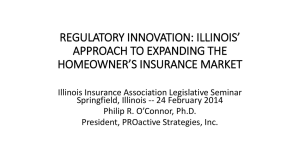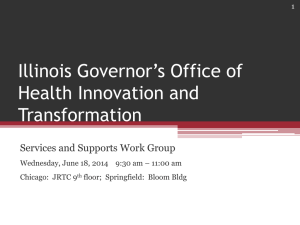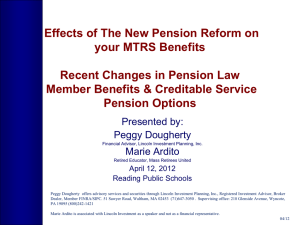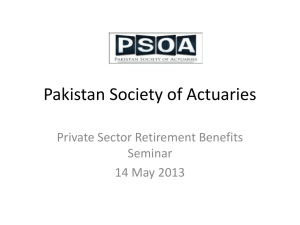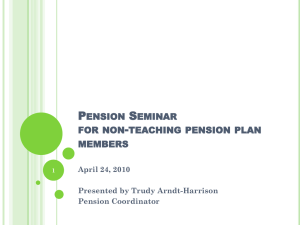Illinois Public Pension Systems: Funding, Solvency & Legality
advertisement
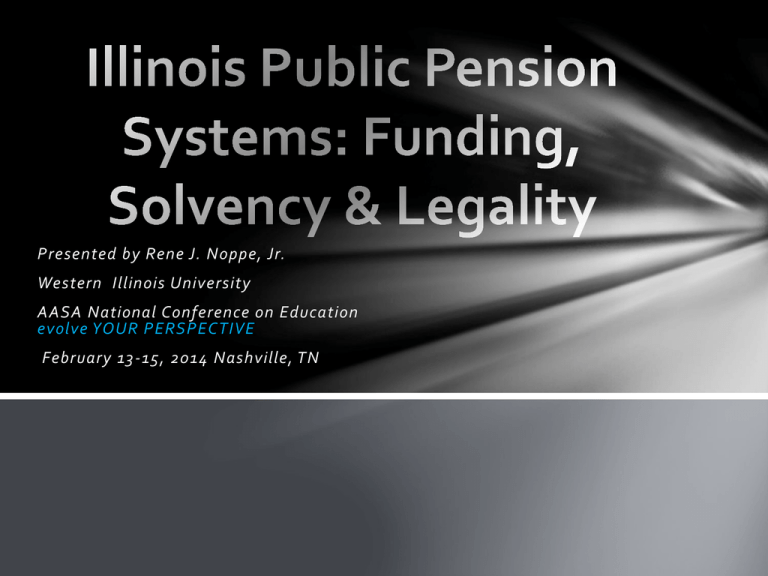
Presented by Rene J. Noppe, Jr. Western Illinois University AASA National Conference on Education evolve YOUR PERSPECTIVE February 13-15, 2014 Nashville, TN PART 1 A. Illinois State Public Pension Systems B. Illinois Public Act 098-0559 C. Rationale for the P.A. D. Failed attempts at pension “reform” legislation E. The 1970 Illinois State Constitution a) Article XIII Section 5 b) Article XIII Section 3 Illinois Retirement Systems Illinois has 13 systems covered under the Illinois Retirement Systems Reciprocal Act. Discussion is limited to “the 5 state retirement systems” below: 1. State Teachers’ Retirement System TRS 2. State Universities Retirement System SURS 3. State Employees Retirement System SERS 4. General Assembly Retirement System GARS 5. Judges Retirement System of Illinois JRS 6. Illinois Municipal Retirement Fund IMRF Illinois Public Act 098-0559 P.A. 098-0559 (aka SB 1) “The Pension Reform” bill was adopted December 3, 2013 by the Illinois General Assembly. Effective: 6/1/14 The legislation reduced benefits for future and current retirees in 4 of Illinois’ 5 major public pensions. (Yes, they reduced current retirees pensions) The required state contribution for FY 2013 to the 5 state retirement systems total $5,868,300,000. Is there a problem here? Did this happen overnight? State Rationale for P.A. 098-0559 Illinois has: (from PA 098-0559 Section 1. Legislative Statement) 1. the lowest credit rating of any state; 2. increased its cost of borrowing as a result; 3. increased its income tax; 4. reduced retirement benefits for new hires-2011; 5. budgeted cuts to important state programs; 6. an accrued pension debt $100,000,000,000.00; 7. determined the problem can’t be solved w/o violating the Illinois Constitution Attempts to Reform Pensions The Illinois General Assembly (GA) has long wanted to address the public pension issue. (Last 5 years) HB 1165; HB1154; HB1166; and SB 1; SB35; were attempts by the GA to reform the public pensions of Illinois. (None of these passed) All of these provided for a decrease in COLA’s and increase retirement age. (“Reform” means “Reduce”) SB 2404 was proposed by “We Are One Illinois” coalition (union) which called for a 2% contribution increase by the employee – No Benefit Reduction. P.A. 098-0559 & Illinois Constitution Article XIII General Provisions (Pension Protection Clause) Section 5 of Article XIII of Illinois Constitution states: Membership in any pension or retirement system of the State, any unit of local government or school district, or any agency or any instrumentality thereof, shall be an enforceable contractual relationship, the benefits of which shall not be diminished or impaired. Is this statement unclear? Illinois General Assembly Oath Article XIII General Provisions (Oath of Office) Section 3 of Article XIII of Illinois Constitution states: “I do solemnly swear (affirm) that I will support the Constitution of the United States, and the Constitution of the State of Illinois, and that I will faithfully discharge the duties of the office of…to the best of my ability.” Is this statement unclear? Illinois Public Pension Systems Teachers’ Retirement System-TRS 39th largest pension system in U.S. (Created originally in 1915 and current system in 1939) Provides retirement, disability, death & survivor benefits (Annual compounded 3% COLA) Teachers, administrators, and other certified personnel employed outside Chicago 366,000 members $36.5 billion in assets as of June 30, 2012 $90 billion in accrued liabilities TRS cont’d TRS requires teachers to belong and contribute: 4% of Salary in 1939 increased periodically to 9.4% in 2005 Teachers do not participate in Social Security Retirees do NOT pay Illinois state income tax TRS is a qualified pension plan under provisions of the Internal Revenue Code, Section 401a PA 098-599 may negatively impact the above standing TRS cont’d TRS is funded from the following sources: 1. Member contributions, (9.4% of salary) 2. Investment income, 3. Employer contributions 4. Illinois state appropriations TRS has a funding ratio of about 40% The actuarial recommendation is 90% by 2045 State Universities Retirement SystemSURS One of the 100 largest pension system in U.S. (Originally created 1941 with current system 1963) Provides retirement, disability, death & survivor benefits (Choose from 3 plans) Professors, teachers and support staff (clerical, service workers) of public higher education 81,000 active members/217,000 total $13.7 billion in assets as of June 30, 2012 $19.3 billion in accrued liabilities by 2045 SURS cont’d SURS requires teachers to belong and contribute 8% of Salary Professors do not participate in Social Security Retirees do NOT pay Illinois state income tax SURS is a qualified pension plan under provisions of the Internal Revenue Code, Section 401a PA 098-599 may negatively impact the above standing SURS cont’d SURS is funded from the following sources: 1. Member contributions, (8% of salary) 2. Investment income, 3. Employer contributions 4. Illinois state appropriations SURS has a funding ratio of about 40% The actuarial recommendation is 90% by 2045 State Employees Retirement SystemSERS Provides retirement, disability, death & survivor benefits to various state agency employees (Created in the 1940s) Social security benefits are offered to all state employees who elect to participate 61,545 active members / 51,994 retirees $11.8 billion in assets as of June 30, 2012 $34.7 billion in accrued liabilities SERS has a funding ratio of about 25% General Assembly Retirement SystemGARS Provides retirement, disability, death & survivor benefits to all members of the General Assembly, Governor, Lt. Governor, Secretary of State, Treasurer, Comptroller and Attorney General (Created in 1947) Participation is not required Certain clerks and secretaries to the House and Senate may participate after 10 or more years of service GARS cont’d $56.1 million in assets as of June 30, 2012 $247.4 million in accrued liabilities GARS is funded by: 1. Member contributions set at 11.5 % of salary 2. State appropriations 3. Investments GARS has a funding ratio of about 18.5% Judges Retirement System-JRS Provides “retirement…of judges who are aged or otherwise incapacitated…for old age, disability, death and termination of employment” (Created 1941) 968 active participants / 665 Retirees $601.2 million in assets as of June 30, 2012 $2.022 billion in liabilities JRS was not included in the Illinois Pension Reform Legislation (P.A. 098-0559) JRS cont’d JRS is funded by: 1. Member contributions set at 11 % of salary 2. State appropriations 3. Investments GARS has a funding ratio of about 29.7% Illinois Municipal Retirement FundIMRF Provides retirement, disability, death benefits to employees of units of local government (Created in 1939) All non-teaching staff in school districts, and cities, counties, villages, park districts, and townships (except City of Chicago and Cook County) Over 42 types of local government participate covering nearly 3,000 units of government A unit of government cannot withdraw from IMRF IMRF cont’d 182,000 active members / 80,000 retirees Hourly standard is 600 or 1,000 hours in 12 month period (School districts are under the 600 hour rule) IMRF is funded by: 1. Member contributions 4.5 % of salary 2. Employer contributions (fluctuates yearly) 3. Investments 4. NO funding from the State of Illinois IMRF cont’d Each unit of government is a separate pension plan School districts are informed each Spring as to its IMRF contribution rate for the next year School districts have the authority to levy real estate taxes to satisfy the employer’s obligation to IMRF (In 2009, 9.7% of payroll) (In 2011 12.4 %) IMRF benefits are a recruitment tool State underfunding of pensions doesn’t affect IMRF IMRF cont’d A majority of IMRF employees are also in Social Security IMRF has a funding ratio of about 84.5% (2010) PART 2 A. Funding equity B. Pension solvency C. Lawsuits D. Increased district costs Funding Equity The major pensions: A. Different salary contributions 8% - 11.5% B. Different years of service requirements-e.g. while not covered in presentation, teachers need 20 years to be vested, judges 4 years. (IMRF is 8 years) C. Funding ratios vary from 18% to 40% (IMRF is 85%) D. Chicago school district can levy for teacher pension Equity cont’d E. Judges Retirement System excluded from new law reducing pension benefits F. IMRF excluded from new law reducing pension benefits G. New length of service years dependent on current (Age 46+ = no delay; 31 = 5 year delay) H. COLA “skip” on basis of age (2, 3, 4, 5 yrs. rule) (Age 50+ = no 2nd COLA; graduated to 43 or below = no 2nd, 4th, 6th, 8th, or 10th COLA) Equity cont’d I. IMRF can levy for pensions and social security J. Teachers and other active pension members have always paid their assigned contributions K. Many teachers were required to enter nonrevocable agreements to retire L. The inequities of the Tier II pension legislation has not been touched in this presentation (e.g. the age to retire at 67) Future Solvency A. Illinois has not funded its obligations: • Late payments to public agencies AND • Payments are less than obligated amounts B. Major retirement system pensions have not been adequately funded by the state C. State of Illinois financial shortfall estimates are in the $BILLIONS D. So…is P.A. 098-055 the solvency solution? Solvency cont’d Some think NOT P.A. 098-0559 is hailed by some as historic and groundbreaking and is expected to save Illinois $160 million over 30 years A University of Illinois study projects the state’s major pension systems will eliminate their unfunded liability by 2045 But, the state’s deficit is projected at $13 billion…only $1 billion less than if the “reform” did not occur Solvency cont’d The U of I “Fiscal Futures” Project blames the deficit on regular overspending by the Legislature If the temporary income tax increase is rolled over, the Illinois deficit will reach $7 billion by 2025 ( a reduction of ½) The pension reduction act cuts benefits, decreases employee contributions, increases the retirement age and has caused the filing of lawsuits to challenge Solvency cont’d Illinois Governor’s Office outlined deficits in early January if the income tax increased is allowed to sunset: State deficit projection: $1.9 billion in 2015; $4.1 billion in 2016 State backlog of bills projection: $5.6 billion in 2014 $16.2 billion in 2016 Lawsuits Two lawsuits have been filed against the reform legislation in Cook and Sangamon counties in IL More are in the planning stages… If they are successful in turning over the reform legislation many believe the General Assembly will look at legislation to pass pension costs on to local districts (Referred to as “the Cost Shift”) Currently this process for funding is used for IMRF Increased School District Costs The transfer or “Shift” of the State’s cost for teacher pensions to the local districts will get the state out of the teacher pension business This increase in costs will challenge already cash school districts unless there is some type of “phase in” In 2011 all school districts in Illinois had a combined fund balance reserve of $13 billion Coincidentally, Illinois had a deficit of $13 billion The General Assembly knew that!!! DISCUSSION R-Noppe@wiu.edu http://trs.illinois.gov members@trs,illinois.gov www.surs.org https://www.srs.illinois.gov/Judges/history_jrs.ht ml (40ILCS) Illinois Pension Code



